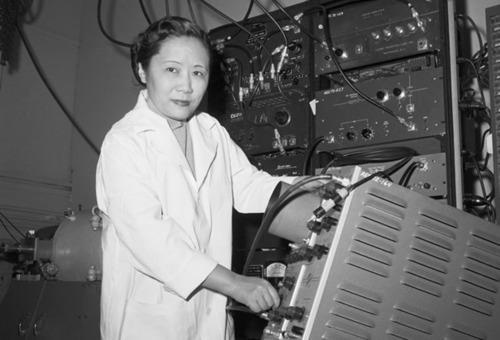The legend of Wu
It is time to look more closely at the famous Chien-Shiung Wu. How does a Chinese woman born in 1912 become America's foremost experimental physicist (of any origin or gender)? How do the events of our story fit in the arc of her career development?
We'll start with the basic biography. Raised in a village near Shanghai, educated at women's primary and secondary schools, studied physics at North Central University in Nanking from 1930-34, continuing graduate work until 1936, when she and a young female chemist gained admittance to U.S. universities and set off to America.
Wu settled in at U.C. Berkeley, worked directly under Ernest Lawrence, and earned her Ph.D. in 1940. She stayed there as a lecturer and researcher for several years, marrying another Chinese-American physicist Luke Yuan. She then followed academic opportunities to Smith College and Princeton, but returned to laboratory work at Columbia in 1944, where she played a key role in developing instrumentation for the gaseous diffusion process for uranium separation, an important component of the secret Manhattan Project.
She stayed at Columbia after the war and until her retirement as research associate (1946-52), associate professor (1952-57), professor of physics (1958-72), and Michael I. Pupin Professor of Physics (1972-81). We are already familiar with her most famous achievement, the 1957 confirmation of parity violation. That capped her years of work on beta decay and led to further successes in the unification of the electroweak force in the 1960s. Her text Beta Decay (1965) remains the standard reference in the field.
She won just about every honor except the Nobel Prize, among them the Comstock Award, National Medal of Science and Wolf Prize in Physics. She holds many firsts, including first female recipient of a Princeton honorary doctorate (1958), first Chinese-American member of the U.S. National Academy of Sciences, first female president of the American Physical Society (1974); and the first recipient of the Wolf Prize (1978).
She passed away February 16, 1997, in the Upper West Side Manhattan apartment where she had lived for more than 50 years.
There is much more, of course, and I'll want to come back for a deeper look in the future. But this gives context for understanding the crucial events of our story. While Wu's reputation will grow formidably later on, when Stan encounters her in the Columbia physics department in the late 1940s, she is still just a research associate—someone who might have influence in the lab but who is not in position to be his doctoral advisor.
This brings us to the subject of Stan's academic career. What do we know of his progress through undergraduate and graduate school after he got back from the war? Quite a lot, actually, which I will review in a coming post.

